Turbos ~ Love Me, Love Me NOT!
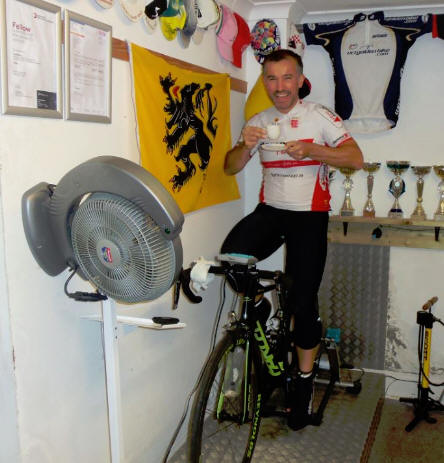
George de Sousa
about to undergo a Ramp
Test at the flamme
rouge Service Corse
Preparation is everything...
Okay, here we are, the torture instrument we love to hate. For all you turbverts out there, and those yet to be converted, here's a little info on the differing types, advantages, disadvantages, how they handle power and what you need to get the best out of them...
Why The Turbo...
When I started cycling
to race, rather than deliver papers or get to work, a "turbo" was exactly that.
It was a frame you bolted your front forks into, and the back wheel
rested on a roller with two plastic, turbine-like, fans that made a
noise that would drown out a helicopter.
There was nothing else. You chose between rollers or this contraption, and VHS or Betamax. Life was so much easier back then...
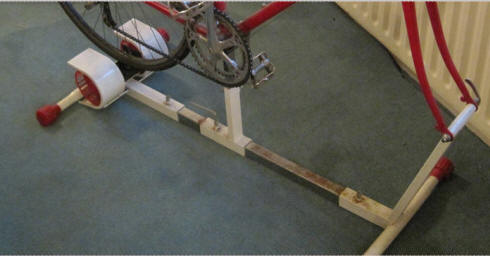
As you can see, "the rack" was probably the worst
instrument devised by man since medieval times. I rode one
twice before getting rid and riding on the road. No matter
what the weather, it was better than the alternative.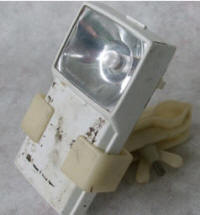
In those heady days, all we had were Wonder Lights, the streamlined, lightweight sensation from France. When the batteries were new you could almost see to the edge of your front wheel.
On our chain-gangs only the front and rear pairs of riders put their lights on, everyone else switched off to save battery power.
Car traffic was half then what it is now, and all shops closed at 6 pm, so all was good. And no one dared wear a helmet for training, for fear of ritual humiliation.
Now, we have lighting that has improved by orders of magnitude, as have turbo's themselves. The choice range for both is enormous. I don't do dark; the last time I was out at night was for the Ventoux 24 hour Challenge. There will be no lighting reviews done here, so for now, it's just turbo's, or their new fangled millennium equivalents...
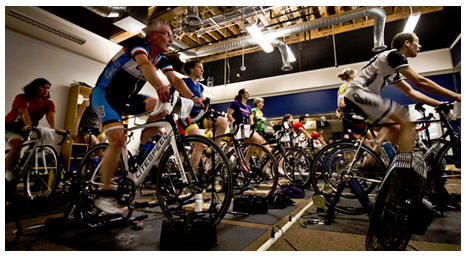
Sometimes it's better with company
The Cycle University ~ West Seattle
Choose Wisely
First there was wind, and only wind. Now there's; electric, magnetic, fluid, air,
powder, wheel in, wheel out, computer-linked, internet-linked, ANT+,
power meter driven, Bluetooth connected , cable controlled,
wireless, value priced, over priced and everything in between.
For some trainers you don't even need a bike!
A very quick synopsis. Most indoor trainers (I will continue to call them turbo's) have a sturdy frame that holds a roller of some sort. In the frame is a latch mechanism, which holds your back wheel by the skewer.
You put their skewer in to your wheel, drop it in to the frame, lock it in using a variety of ingenious (but not always simple) methods. For some, that's it. For others there's various front wheel raising blocks, resistance levers, wind slides, cadence magnets, wires, clips, head units, PC's and other gizmos to play with.
I'm all for choice, but sometimes there can be too many choices. First I'll cover the main "resistance units"...
Wind/Air Based Resistance
These are generally the least expensive of units and apart from the
roller bearings, there is very little to go wrong with them.
You put your bike on and pedal, as simple as that.
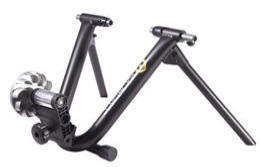 The
faster you pedal the more resistance is generated. Resistance
while significant, isn't that high. So you can't do big power
or strength building sessions
on them.
The
faster you pedal the more resistance is generated. Resistance
while significant, isn't that high. So you can't do big power
or strength building sessions
on them.
But they are fantastic for aerobic and threshold work and will probably cover 80% of what you want to do.
The only drawback is they are incredibly noisy. So you need to be away from family and friends! Very cheap, very reliable and CycleOps ones come with a lifetime warranty!
Magnetic Resistance Trainers
These come in many forms, from the self-regulating, cable operated
versions, to the PC, computer or head unit programmable versions.
Effectively they are all the same, they just go about altering the
wheel resistance in a different way.
Some need to be plugged in to the mains, some in to a computer. The lower priced ones are mostly stand alone, so can be taken to races or TT's for warming up on!
At the basic level, you have a lever and cable attached to your handlebars and when you click it, it moves the magnets in the roller to create more resistance. Some go from 1 to 10, others 1 to 5, some from -5 to +20!
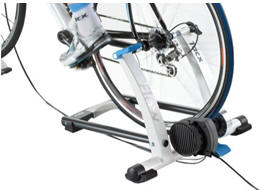 These
are generally quieter than wind units and range in price form £125
to £1250. The higher the price the more controllable, and
higher the resistance they can deliver.
These
are generally quieter than wind units and range in price form £125
to £1250. The higher the price the more controllable, and
higher the resistance they can deliver.
Also the higher priced units generally have "super magnets" to keep weight down and resistance up, with heavier flywheels to make them ride better. How ironic, so choose wisely.
The Tacx Flow turbo, pictured above, requires mains electric feed and has an electronic head unit that measures power, cadence, heart rate, etc. A perfect md-level unit that can be loaded with internet features and programmable sessions.
Fluid Resistance Trainers
The main players in this market are CycleOps and Elite. Effectively
they are an impellor sitting in fluid. The faster you pedal
the further to the edge of the impellor the fluid gets thrown, thus
increasing resistance.
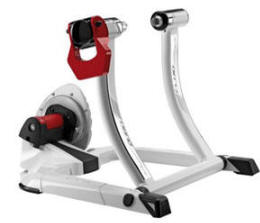 They
can be temperamental, and inconsistent, especially on very cold or
very hot days when the viscosity of
the fluid changes. They also have a sharper resistance curve,
which means the faster you pedal the much harder it gets.
They
can be temperamental, and inconsistent, especially on very cold or
very hot days when the viscosity of
the fluid changes. They also have a sharper resistance curve,
which means the faster you pedal the much harder it gets.
So trying to do leg speed work on them can be quite challenging.
Generally, they don't need electricity to run, but have more "parts" in them than other units, so they tend to be heavier and bulkier.
They are reliable, but they do have the scope for issues, due to fluid seals and potential leakage. But build quality is good, it's just my opinion.
This is the Elite Power Fluid, with elastogel roller, rather than a steel one. It quietens the ride, but at the expense of tyre wear. They also do a "magnetic powder" version that replicates fluid units but without the risk of leakage. A choice within a choice.
Other Options...
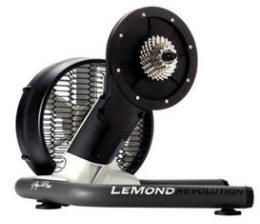 The LeMond Trainer is an excellent machine
that takes the rear wheel out of the equation, meaning you don't
need a riser block (or telephone directory, for the front wheel.
The LeMond Trainer is an excellent machine
that takes the rear wheel out of the equation, meaning you don't
need a riser block (or telephone directory, for the front wheel.
However the downside is, it weighs 15 kilos and is the noise equivalent of a washing machine and tumble drier running side by side! It also shifts a huge amount of air, so careful where you place it; you'll create havoc.
The Wahoo Kickr is an identical concept to the LeMond Trainer, but using magnetic resistance as opposed to wind. It's almost silent and has a huge potential as it locks in to all the technology you can throw at it.
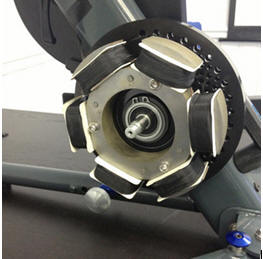 It practically gets controlled by your iphone or ipad.
Shortly there will be apps galore and Golden Cheetah, Ant+ and
Bluetooth support.
It practically gets controlled by your iphone or ipad.
Shortly there will be apps galore and Golden Cheetah, Ant+ and
Bluetooth support.
Connect this to your PC, the internet, your Garmin and probably in the future "android" systems and you have everything you need to future-proof your indoor training.
The only issue will be the gears in the unit. With 10 and 11 speed compatibility issues, you can't just swap bikes if you want to.
If you only have one "gear system" then all other issues, apart from price, appear to melt away...
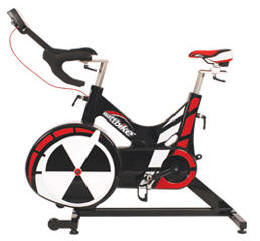 Finally, there's the
spectacularly ugly WattBike and
CycleOps Power Trainer machines.
Finally, there's the
spectacularly ugly WattBike and
CycleOps Power Trainer machines.
Which are huge, expensive, accurate, very nice machines, but solely dedicated to their task.
They come with a variety of software, support and "gadgets" but need a lot of room, if not a dedicated room to house them.
They don't fold away behind the dining room table...
But they do have power, which is nice. But so does the Tacx Flow at the top of the page.
Rollers ~ A Viable
Alternative?
Rollers are a fantastic contraption, but unlike turbo's, they can
bite back! You need to be totally, totally on your guard at
all times with rollers. You can't just unhook your brain and push
the pedals.
Rollers are fantastic for giving you a smooth pedal stroke, building a good core, and keeping you engaged. But they lack versatility and unless the rollers are of a large diameter, can provide little resistance.
Of course you can go up the gears to increase power output, but you can easily find the limit of the rollers before you do for yourself. So rollers are good, but may not be an alternative for some riders.
60 sec Killers
~ In your head, this is what you're doing, the reality is a little different!
See how hard the coach is working? A tough job, but someone has to
do it.
Generally, rollers are complementary to a turbo (as an excellent recovery tool), not a replacement for them. If you want to be on the track or get your leg speed and balance "up there," get rollers! But you'll probably go to a turbo before too long.
What to buy...?
It's not my job here to make recommendations or tell you which is
the right one for you. They are all different and all do
different things differently. Some even do the same things
differently.
Most have dedicated software and mounting systems which are not compatible with each other. So do your research before you buy.
So you need to ask yourself the normal bike related purchase questions and give the following points your consideration...
▼ what is your budget
▼ do you have mains power available
▼ dedicated area & bike or does it have to fold away
▼ is noise an issue; are you in a garage or a top floor flat
▼ do you want to "race" others on the t'internet
▼ do you want to analyse power/heart/speed files
▼ what are your mates riding; get a recommendation
Then after all that, you make an impulsive buy because the bloke in the shop, or the internet page, convinced you the one they had in stock was the right one for you.
Remember, super sexy virtual reality, video images may look good in the brochure but the novelty soon wears off. You're training to a structure.
It's your training, not someone else's, so make sure you lock in, do your stuff and suffer well. It's not meant to be easy!
Dr Richard Worth ~ wVO2max Test 30 secs out of 6 minutes of hell...
Things you need
to know
A big fan. You will get hot, so get a big fan and get
it pointed at the top half of your body and face. As with
the boys in the lab photo's.
For the same reason, get a towel over the handlebars and a sweat thong (oo-er) for the bike. It's not as big an issue now as it used to be, but on steel bikes, sweat was a corrosive killer (see the old turbo at the top of the page). Protect your machine.
And a front wheel raiser is important. A proper block is good, but an old telephone directory is a good stand in.
Get a large, 750 ml, drinks bottle for the bike. If you don't drink it fine. if you need it, it's a life-saver.
And finally, music! Get a playlist that gets you through the session. And if you're looking for sessions, we have loads in our 65 page Self Coach Manual or here for free on our Drills Pages...
Finally, get yourself comfortable. You're going to be stuck on this machine for up to an hour. So make sure there are no distractions, no draughts, no children (swishing back wheels can make a mess of little fingers) or pets (it's the same for paws and noses).
You will get a "numb bum". The rear wheel is locked in place at the spindle taking out all of the give of the wheel and spokes. All the vibrations will come up through the bike and seat post to your nether regions. Don't wear your old worn out shorts with the tissue paper chammy. Be nice to your privates.
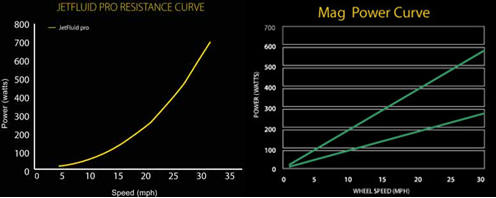
Power, Curves & Accuracy
If you are using power then it's nice to know that what you are
measuring is accurate, and if not accurate at least consistent.
I recently did a test with local rider Jason Stratford
to map his fluid turbo against an SRM output to correlate the increasing resistance curve. So we knew (for instance) that at
15 mph it requires 150 watts to power it; at 20 mph, 250 watts; and
at 30 mph, 450 watts etc.
We did this with ANT+, Golden Cheetah and some very tricky polynomial equations. He did the cranial stuff, I just did the pedalling!
Different turbo types have differing resistance curves. Generally, the fluid turbo's follow the left hand resistance characteristics; a gradually, then exponentially increasing ramp.
Magnetic turbo's (right-hand panel) have a more linear trajectory, although some curves (depending on their magnetic power) increase more rapidly than others.
And some of the ergometers (clever turbo's) have a configurable resistance curve that can be manipulated to suit your needs. Keep it low to allow high legspeed, high power sprints. Or ramp it right up to simulate alpine passes with low legspeed, high power climbing efforts.
In a parallel universe, Brighton Mitre's Puncheur wining rider, Gavin Starling did some PowerTap correlation with his Tacx Bushido and found some decent info to help in your research.
At the start of the session the Bushido was over reading by 20% compared to his PowerTap. But after a ten minute warm up and a calibration reset, he recorded correlation figures of between 95-97%.
This tiny discrepancy can be explained by the difference between "measuring" at the PowerTap hub and the "calculations" from the wheel of the Bushido. The main difference can be attributed to the frictional losses between the two units. So all is good; these figures are well within the expected margin of error.
But (in the real world) it matters not what the numbers are, as long as you use the same method to measure your sessions; speed or power. An improvement is an improvement as long as your results are consistently measured it will be fine.
The numbers only mean something when they are compared to someone else's. Which is why you take all non-corroborated power figures with a pinch of salt. Even then, they mean nothing without knowing the rider's weight!
So always set your tyre pressure to (say) 100 psi. Always do a good ten minute warm up. Recalibrate if you can before the start and always apply the same roller pressure to the wheel. Keep all variables to a minimum.
The Message
As with all things cycling related, do your research and buy the
best equipment you can afford that does the job you want it to.
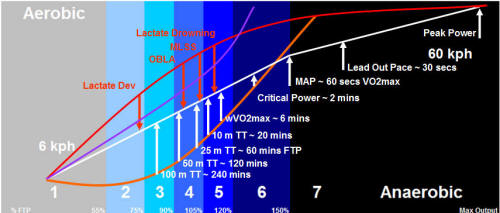
Personally, I find the entry level systems work well if all you want to do is follow a session and pedal. None of our sessions require any fancy video gimmickry, power measuring or heart rate monitoring(as long as it's beating is fine). If you have them, well that's good, but it's by no means essential.
Merckx never had a power meter!
Mid range trainers are excellent, and twice the price of entry level units. But they're not twice as good as the "top end" entry level systems. The real top end ones are fantastic, but are probably overkill for what you need as a training tool.
Remember, a turbo is just a tool to get you through the winter. You don't need to spend a grand on turbo hardware, that needs to connect to a grand's worth of PC, laptop or TV equipment, to get you fit. A £150 turbo and a big fan and some banging tunes is all you need.
Get yourself comfortable, get yourself ready and get your head down and pedal for an hour maximum.
An hour on the turbo is worth two on the road. And when you finish, you're already home and haven't had to dodge any over caffeinated, irate, wound up commuters who've had a bad day at work and have decided you're going to pay for it on their way home.
All you have to do, is suffer well...








